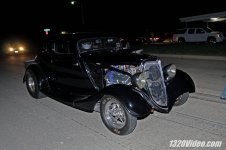Shoot at the lowest ISO that you can get away with.
Unless you want the grain or maybe even some noise for whatever reason...
IMO grain is not bad it is just an "effect" just like sharpness.
Grain doesn't necessarily equal "noise".
Shoot at the lowest ISO that you can get away with.
Correct me if I'm wrong here, but as I understand it, the ISO is a combination of both the aperture and the shutter? If so, is there a setting where you can adjust them independently on the D3100?
Way back when some of us Dinosaurs roamed the Earth with cameras that shot film, we would buy film by it's ISO value.
Kodak ISO 400 for everyday stuff and ISO 800 if you needed faster film for sports.
Ken, I enjoy your answers, lol.
Way back when some of us Dinosaurs roamed the Earth with cameras that shot film, we would buy film by it's ISO value.
Kodak ISO 400 for everyday stuff and ISO 800 if you needed faster film for sports.
I get the impression you think Ken is joking. He's not, you know.
Or ASA 100 for daylight stuff and ASA 160 for skin...and if you go way back in the day those old plates were rated about 4 ASA...I think Kodachrome was introduced at 25 ASA maybe???
I'm am going to give you an old ancient piece of photography advice Maxie and it is this - A camera with a sharp f2 or f2.8 lens and a shutter speed of at least 500 will be all you ever need.
Max some folks are naturally gifted and they can make good snaps as easily as they breath air. Then there are folks that work and study and shoot their @sses off and yet they still make basically mediocre snaps (I am one of these unfortunate individuals) When you talk about starting from the beginning the most important aspect of photography is dealing with contrast. Timing comes next and then composition. Figure out those three things and your snaps may still be mediocre but at least they will display technical acumen which other folks can see if they are smart enough to see it. These three things are not all of it by any means just the most basic of basic fundamentals. Photography is very convoluted like playing a violin or piano or something...many folks can make Silent Night sound decent but few can make it sing. The best never get stuck in a groove either they are always learning, watching, waiting, studying, and striving to make a better snap than the last one.
Kind of funny, I think I might have the timing... I'm a drag racer and timing is everything and I think that might help... I just need to work on the others. However, one thing that is most confusing to me is composition, I really have no idea what that is.

My take on photography composition is an exercise in combing multiple elements together to tell a story.
Take drag racing as an example. You are staged at the light, but you are not fixated on the strip with tunnel like vision. That would be a boring story. You see things in the foreground like the lights, the hood of your car. Mid ground you see maybe the front corner of the car of the guy staged next to you, the bleachers full of spectators. Then the background may have the Ambulance parked behind the guardrail before the rest of the frame fades off into infinity. That is quite a more interesting story right?
Don't fixate on one item but include other elements or control the placement of elements in the frame to create an interest to the viewer is what I try to capture.
Like riding a motorcycle, I go into a zone of hyper awareness. One eye is watching the road ahead, the other eye is watching the pickup truck about to turn left in front of me, while my third eye is checking for an escape path in my mirror. I am looking ahead but I am seeing all these other things as well.
Composition focuses on a main subject while including elements in the peripheral. You maybe focused on the prey but you are also processing information from the rest of your vision.
